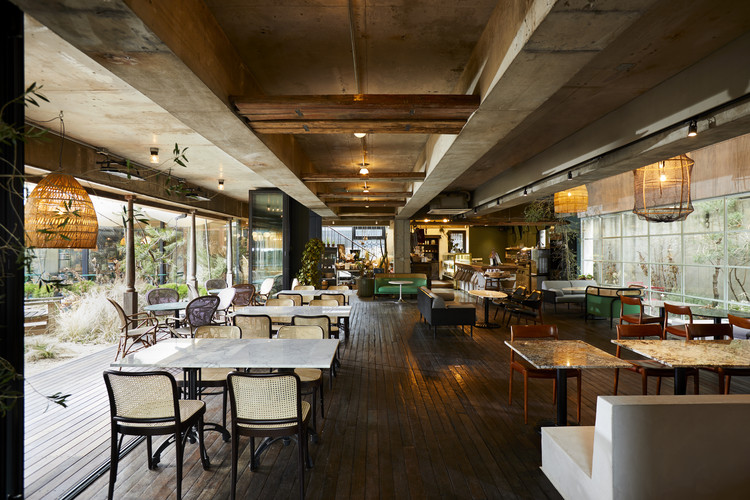OPENs Competition Entry for New Shenzhen Art Museum and Library
2016-01-04 12:00
From the architects: Design Concept
龙华美术馆和图书馆是深圳2015年最重要的公共文化项目之一。这是我们反思和反思中国城市大规模建设公共文化建筑的一个机会,并提出一套新的战略,创造出更开放、更具适应性、更具启发性和技术创新、但仍深深植根于深圳本土文化的新一代城市文化中心。
Longhua Art Museum and Library is one of the most important public cultural projects that Shenzhen will undertake in 2015. It is an opportunity for us to reflect and rethink the massive making of public cultural buildings in Chinese cities, and come up with a new set of strategies, to create a new generational of urban cultural centers that are more open, adaptable, inspiring and technologically innovative, yet still deeply rooted in the local culture of Shenzhen.
Courtesy of Open Architecture
我们试图在这个设计中重新定义未来艺术博物馆的可能性,它的画廊空间像一层中国卷轴画一样水平扩展,模块化和连续的在一层,以带来最大的馆藏灵活性和容易观看的体验;它的艺术存储垂直扩展,以适应未来博物馆藏品的增长。
We seek to redefine the possibilities of future art museums in this design, with its gallery spaces expand horizontally like a Chinese scroll painting, modular and continuous on one floor, to bring maximum curatorial flexibility and easy viewing experience; and its art storage expands vertically, adaptable for future growth of the museum collection.
图书馆以其垂直的组织结构,为大楼内的图书交通提供了最大的效率,而看似平凡但极其复杂的现代图书储存和流通过程,则成为城市和轻轨经过的壮观景观。基于独特的操作时差、过滤和从城市噪音过渡到禅宗般的安静,书籍阅读体验被组织成不同的空间拓扑。
The library, with its vertical organization, provides maximum efficiency for the book traffics in the building, while the seemingly mundane yet hugely sophisticated modern process of storing and circulating books becomes the spectacular view for the city and the light rail passing by. The experience of reading in books is organized into distinctively different spatial topologies based on the unique operation-hour difference, filtering and transiting from urban noise to zen-like quietness.
Courtesy of Open Architecture
设计概要要求为这两个独立机构建立两座独立的建筑。我们强烈认为,两者之间的关系将对城市空间的特征产生重大影响。与其彼此面对两个孤立的积木,不如让它们共同形成一个整体,成为新城市中心的焦点。这些机构可以独立管理,但同时也是相互联系的。通过消除这两座建筑之间的差距,我们还最大限度地满足了它们的规划需要。
The design brief calls for two separate buildings for the two independent institutions. We strongly felt that the relationship between the two will have a significant impact on the character of the urban space. Rather than two isolated building blocks confronting each other, it would be much stronger to have them jointly forming one mass that will become the focal point of the new urban center. The institutions can be managed independently, yet also connected at the same time. By removing the gap between the two buildings, we also maximized the horizontal presence for their programmatic needs.
Courtesy of Open Architecture
我们希望这座建筑将以一种非常开放和欢迎的方式展现出来,让每个人都能接触到艺术和书籍。通过建设公共建筑和开放空间,我们可以培养一种自由、慷慨和积极的城市精神。
We hope the building will manifest itself in a very open and welcoming way, and let the arts and the books be accessible to everyone. Through the making of public building and the open spaces, we can foster an urban spirit that is free, generous and positive.
Courtesy of Open Architecture
这座建筑被抬离地面,建造了一个漂浮的讲台,把整个场地变成了一个向所有公民开放的城市公园。在漂浮的平台上,空间向上和向下都在增长,就像自然界中的有机构造一样。大型遮阳公共广场非常适合亚热带气候。
The building is lifted off the ground to make a floating podium, transforming the entire site into an urban park open to all citizens. From the floating podium, spaces are growing both upward and downward, as the organic formations found in nature. The large shaded public plaza works perfectly for the subtropical climate.
Courtesy of Open Architecture
Courtesy of Open Architecture
艺术画廊和图书馆都有一个相似的地方-对存储空间、艺术或书籍的日益增长的需求。我们并没有采取将仓库限制在地下室的正常策略,而是承认了不断增长的存储空间的重要性,并设计了一座能够垂直扩展的艺术存储塔;一座体积庞大而紧凑的图书存储大楼,有效地流通了大量的书籍。
Both the art gallery and the library share one thing similar—the ever growing needs of storage spaces, for arts or for books. We did not adopt the normal strategy of confining storages into basement, rather we acknowledged the importance of the growing storage, and designed an art storage tower that can expand vertically; a massive and compact book storage building that efficiently circulates the vast amount of books.
对于艺术画廊来说,水平扩张的建筑使得几乎所有的画廊空间都能容纳在一个连续的楼层上。画廊被设计成一个模块化的开放系统,它提供了前所未有的灵活性:画廊可以根据馆长的需要自由划分,或者所有的画廊墙壁都可以拆除,以容纳大型的艺术展览。
For the art gallery, the horizontally expansive building made it possible to accommodate almost all gallery spaces on one continuous floor. The galleries are designed to be a modular open system that provides flexibility never seen before: galleries can be partitioned freely as the curators need, or all gallery walls can be removed to accommodate large art expos.
因此,建筑既可以垂直增长,也可以水平增长,适应灵活的功能需求。由此产生的建筑质量也形成了强烈的视觉特征。
Thus, the building can grow both the vertically and the horizontally, adapting to flexible functional needs. The resulting building mass also forms strong visual identities.
Courtesy of Open Architecture
在主要规划空间的浮动巨型形式中,我们创造了一系列的景观-这些节点旨在为空间体验注入惊奇和诗意,并鼓励公众探索新的方式来居住这一独特的公共文化建筑。它们给城市空间带来了生机。
Within the floating mega-form of main programmatic spaces, we created a series of spectacles – these nodes are aimed to inject the surprise and poetry to spatial experience, and encourage the public to explore new ways to inhabit this unique public cultural building. They bring life to the urban spaces.
Courtesy of Open Architecture
建筑师开放建筑选址广东深圳市李湖黄文静馆藏原则72600.0平方米2015年开放建筑摄影师介绍
Architects OPEN Architecture Location Shenzhen, Guangdong, China Category Library Principles in Charge Li Hu + Huang Wenjing Area 72600.0 m2 Year 2015 Photographer Courtesy of OPEN Architecture
 举报
举报
别默默的看了,快登录帮我评论一下吧!:)
注册
登录
更多评论
相关文章
-

描边风设计中,最容易犯的8种问题分析
2018年走过了四分之一,LOGO设计趋势也清晰了LOGO设计
-

描边风设计中,最容易犯的8种问题分析
2018年走过了四分之一,LOGO设计趋势也清晰了LOGO设计
-

描边风设计中,最容易犯的8种问题分析
2018年走过了四分之一,LOGO设计趋势也清晰了LOGO设计



























































































